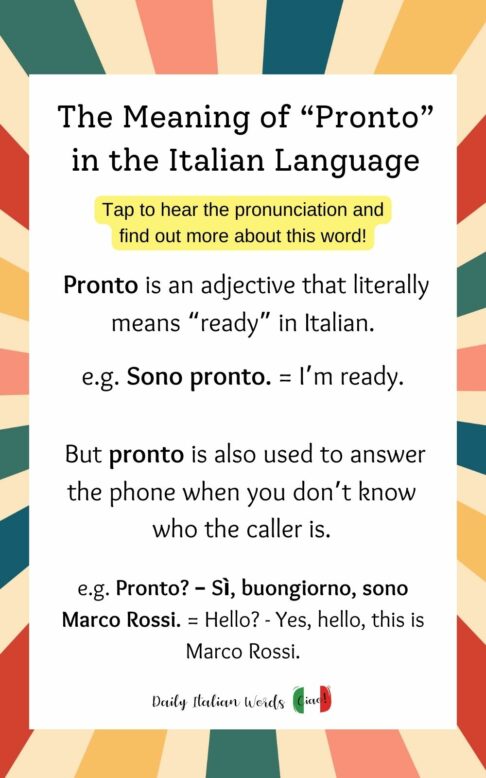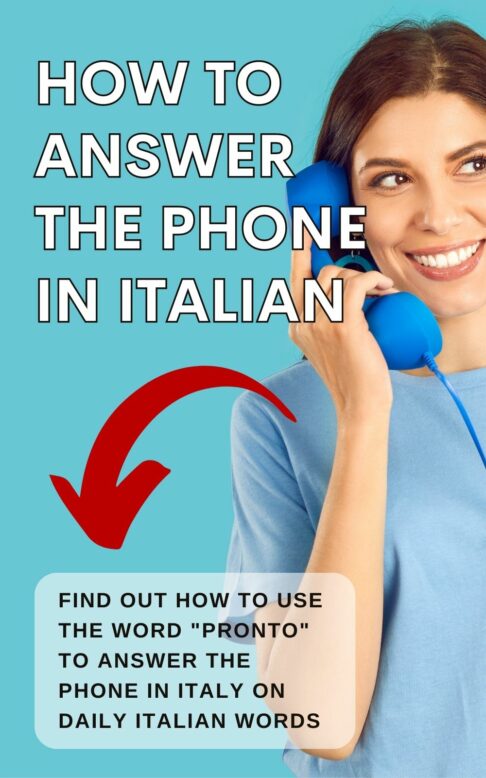When we answer the phone in English, and we don’t know who the caller is on the other end, we almost always start the conversation with the word “Hello?” with a rising intonation.
Italians, on the other hand, will always respond with the word “pronto” which literally means “ready” or in this specific case, “ready to speak“.
Pronto?
Hello?

Italians may say “Pronto?” with the same rising intonation as the English “Hello?” to imply the complete phrase “Pronto, chi parla?” (Hello, who is speaking?). However, you’ll also hear a more straightforward “pronto,” without the rising intonation, which simply means “I’m ready to talk.”
The practice of answering the phone with “pronto” in Italy harks back to the era when telephone calls were manually connected by an operator. When placing a call, individuals would contact a switchboard operator who, after receiving the connection request, patiently waited for an available line. As soon as the line became free, the operator would confirm its readiness with the word “pronto,” indicating that the call was now ready to proceed.

Soldiers and law enforcement personnel were among the earliest adopters of the telephone, using it primarily to respond swiftly to commands from their superiors. This military influence likely contributed to the direct and efficient tone commonly associated with answering the phone with “pronto.”
Although modern times have brought about automated phone systems, eliminating the need for operators, the tradition of answering the phone with “pronto” has endured, serving as a nostalgic reminder of the telephone’s earlier days in Italy.
Important: Those who identify as female shouldn’t make the mistake of responding to a telephone call using the feminine version “pronta.” The reason is that the adjective “pronto” refers to the phone (which is the masculine noun “telefono“) and not to the person who is answering the call.
There are a few of exceptions to the “pronto” rule in Italian. Specifically, the informal “ciao [nome]” (hi [name]), in addition to the formal “buongiorno [nome]” (hello [name]), can be used if you have caller ID or a cellphone and can already see who the caller is.
Quite often, businesses will respond with “[name of business], buongiorno” followed by “Come posso aiutarLa?” (“How can I help you?“).
Another way to respond is with a simple “Sì?” (Yes?), which is used a lot between couples or with close family members. Be aware that if you use it with someone you don’t know, it could sound quite rude.
Important: Learners of Italian tend to confuse the words pronto and prego. To find out more about the word prego and its various meanings, be sure to check out our complete article!
How to start a phone conversation in Italian
One important thing to understand is that pronto is not a greeting, but the first thing you or the receiver say to initiate the conversation. It is also a way to confirm you can both hear each other, and that the call has gone through successfully. After that, a greeting and self introduction can follow.
- Pronto, buongiorno, sono [name] = Hello, I’m [name]
- Pronto, buongiorno, sono il signor [name] / la signora [name] = Hello, my name is Mr. / Mrs. [name]
If the person you’re calling is the first to say Pronto? (as in Hello, who’s calling?), you can skip “pronto” and introduce yourself right way, with the option of beginning with sì (yes).
- Pronto? – Sì, buongiorno, sono [name] = Hello, I’m [name]
- Pronto? – Sì, buongiorno, sono il signor [name] / la signora [name] = Hello, my name is Mr. / Mrs. [name]
After introducing yourself, you can ask a series of questions, and even be very polite and apologise for disturbing the other person:
- Mi scusi se la disturbo, parlo con [name]? = Sorry to disturb you, am I speaking to [name]?
- Sei libero in questo momento? / (Lei) è libero in questo momento? = Are you free right now? (informal and formal)
- Vorrei sapere / parlare con… = I’d like to know / speak to…
- Sto chiamando per… = I’m calling to…

How to end a phone conversation in Italian
So, now that you know how to start a phone call, it’s important to learn how to end one. In this case, the options are a bit more varied. People will typically bring a conversation to a close using one of the following expressions:
- Ora devo andare / scappare = I need to go / run now
- A presto = See you soon
- A più tardi = See you later
- A domani = See you tomorrow
- Grazie per la chiamata = Thanks for calling
- Ci vediamo presto / lì / più tardi = We’ll see each other soon / there / later
- Arrivederci = Goodbye
- Un bacio = A kiss
- Ciao / Ciao ciao = Bye / Bye bye*
Note that in Italian, people often repeat ciao multiple times in succession at the end of a phone conversation, allowing them to trail off as they go to hang up.

Useful Italian Phone Vocabulary
- chiamata = call
- chiamare = to call
- telefonare = to call / phone
- fare una chiamata = to make a phone call
- riagganciare = to hang up
- telefono = telephone
- cellulare = cellphone
- comporre / fare un numero = to dial a number
- aspettare = to wait
- squillare = to ring
- squillo = ring
- telefono fisso = landline
- segreteria telefonica = answering machine
Example Italian Phone Conversation Dialogue
Below are three examples of potential phone conversations you might have in Italy. The first two are informal, whereas the third is formal.
Maria: Pronto? (Hello?)
Carlo: Ciao Maria, sono Carlo. (Hi Maria, it’s Carlo.)
Maria: Ah, ciao Carlo. Non avevo riconosciuto il tuo numero. Come stai? (Ah, hi Carlo. I didn’t recognise your number. How are you?)
…
Maria: Ok, ci vediamo lì allora. Buona giornata! (Ok, I’ll see you then. Have a good day!)
Carlo: Buona giornata anche a te! Ciao, ciao… (Same to you! Bye…)
Daniele: Pronto? (Hello?)
Lucia: Ciao Daniele, sono Lucia. Posso parlare con Martina, per favore? Volevo sapere come sta. (Hi Daniele, it’s Lucia. Can I speak to Martina, please? I wanted to know how she is.)
Daniele: Certo, vado subito a chiamarla. (Sure, I’ll go get her now.)
…
Martina: Ora devo andare. Grazie per la chiamata! (I have to go now. Thanks for the call!)
Lucia: Figurati. A domani allora! (No problem. See you tomorrow then!)
Martina: Sì, a domani, ciao! (Yes, see you tomorrow, bye!)
Note how in the third example below, both interlocutors skip the “pronto” altogether. This can happen in formal telephone calls, because the priority for the receiver is to confirm that the caller has reached the right number, and at that point “pronto” becomes redundant (by saying who they are, they are also saying they are “ready” to engage in the conversation).
Company: Noleggi Auto, buongiorno, come posso aiutarLa? (Noleggi Auto, how can I help you?)
Client: Buongiorno, vorrei noleggiare una macchina per una settimana, se possibile. (Hello, I’d like to rent a car for a week, if possible.)

The meaning of “pronto” in Italian – Other uses
As mentioned at the beginning of the article, pronto is actually an adjective that means “ready” in Italian, or in some cases “swift” “quick” and even “prone to/inclined“. Because it is an adjective, the ending changes to match the gender / number of the subject being described.
- pronto (masculine, singular)
- pronta (feminine, singular)
- pronti (masculine, plural)
- pronte (feminine, plural)
La cena è pronta.
Dinner is ready.
Sei sempre pronto all’ira.
You’re always prone/quick to anger.
Ti auguro una pronta guarigione.
Wishing you a swift recovery.

Heather Broster is a graduate with honours in linguistics from the University of Western Ontario. She is an aspiring polyglot, proficient in English and Italian, as well as Japanese, Welsh, and French to varying degrees of fluency. Originally from Toronto, Heather has resided in various countries, notably Italy for a period of six years. Her primary focus lies in the fields of language acquisition, education, and bilingual instruction.


